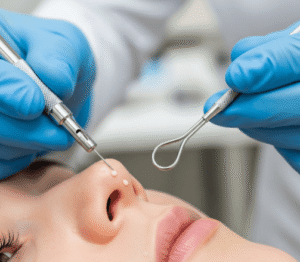Overview
Low blood oxygen, medically referred to as hypoxemia, occurs when the oxygen level in the blood drops below the normal range, compromising the body’s ability to supply oxygen to tissues and organs. Normal oxygen saturation (SpO₂) typically ranges from 95–100%. Levels below 90% may indicate hypoxemia, which can be life-threatening if untreated.
In Korea, hospitals and pulmonary clinics provide comprehensive evaluation and treatment for low blood oxygen, including pulse oximetry, arterial blood gas analysis, imaging, and advanced respiratory therapies. Early recognition is crucial to prevent organ damage, complications, and improve outcomes.
Key Facts
- ➔ Hypoxemia can be acute or chronic, depending on the underlying cause.
- ➔ It can result from respiratory, cardiovascular, hematologic, or environmental factors.
- ➔ Common signs include shortness of breath, fatigue, rapid heartbeat, and confusion.
- ➔ In Korea, specialized care is available in pulmonology and critical care units, offering advanced diagnostics and oxygen therapy.
- ➔ Early intervention improves oxygen delivery, organ function, and overall prognosis.
What is Low Blood Oxygen?
Low blood oxygen (hypoxemia) refers to a deficiency of oxygen in arterial blood:
- ➔ Acute hypoxemia: Rapid onset due to conditions like pneumonia, asthma attack, pulmonary embolism, or trauma
- ➔ Chronic hypoxemia: Long-standing low oxygen levels seen in COPD, interstitial lung disease, or congenital heart defects
- ➔ Clinical significance: Hypoxemia can lead to hypoxia (oxygen deficiency at the tissue level), organ dysfunction, and cellular damage
- ➔ Measurement: Oxygen levels are measured via pulse oximetry or arterial blood gas (ABG) analysis
What Symptoms Are Related To
Hypoxemia can present with a variety of symptoms, which may vary depending on severity and duration:
- ➔ Shortness of breath (dyspnea), especially during exertion
- ➔ Rapid breathing (tachypnea) or rapid heartbeat (tachycardia)
- ➔ Fatigue, weakness, or lethargy
- ➔ Confusion, dizziness, or impaired cognition
- ➔ Cyanosis: Bluish discoloration of lips, fingers, or toes
- ➔ Headache, chest pain, or palpitations in severe cases
- ➔ Sleep disturbances in chronic hypoxemia, often seen in sleep apnea
Early recognition of these symptoms is critical to prevent serious complications.
What Causes / Possible Causes
Low blood oxygen can result from multiple respiratory, cardiovascular, and systemic conditions:
- ➔ Respiratory disorders: COPD, asthma, pneumonia, pulmonary embolism, or interstitial lung disease
- ➔ Cardiovascular issues: Congenital heart defects, heart failure, or shock
- ➔ Blood-related causes: Anemia, carbon monoxide poisoning, or methemoglobinemia
- ➔ Environmental factors: High altitude, poor air quality, or exposure to smoke
- ➔ Neurological causes: Impaired respiratory drive due to stroke, head injury, or drug overdose
- ➔ Sleep-related disorders: Obstructive sleep apnea or hypoventilation syndromes
Identifying the underlying cause is crucial for targeted treatment and prevention of hypoxia-related damage.
When Should I See My Doctor
Seek medical attention immediately if you experience:
- ➔ Oxygen saturation below 90% or persistent shortness of breath
- ➔ Sudden chest pain, confusion, or severe dizziness
- ➔ Bluish discoloration of lips, fingers, or toes
- ➔ Rapid heartbeat, palpitations, or fainting
- ➔ Chronic fatigue or worsening symptoms in individuals with existing lung or heart conditions
Prompt evaluation helps diagnose the underlying cause and prevent serious complications.
Care and Treatment
Management of low blood oxygen depends on severity, cause, and duration:
- ➔ Oxygen therapy: Supplemental oxygen via nasal cannula, mask, or high-flow systems
- ➔ Treat underlying condition: Medications, surgery, or interventions for respiratory, cardiovascular, or hematologic disorders
- ➔ Medications: Bronchodilators, steroids, anticoagulants, or antibiotics depending on the cause
- ➔ Lifestyle modifications: Smoking cessation, pulmonary rehabilitation, and exercise programs
- ➔ Monitoring: Regular pulse oximetry, arterial blood gas tests, and clinical follow-up
- ➔ Critical care: Mechanical ventilation or non-invasive ventilation for severe cases
- ➔ Patient education: Recognizing early signs of hypoxemia and maintaining oxygen therapy compliance
With proper management, most patients experience improved oxygenation, reduced symptoms, and better quality of life.
Treatment Options in Korea
Korean hospitals provide advanced care and multidisciplinary management for hypoxemia:
- ➔ Diagnostic evaluations: Pulse oximetry, ABG analysis, chest imaging, pulmonary function tests
- ➔ Specialist consultations: Pulmonologists, cardiologists, critical care specialists, and respiratory therapists
- ➔ Medical therapy: Targeted medications, oxygen therapy, or surgical interventions based on underlying cause
- ➔ Pulmonary rehabilitation: Exercise training, breathing exercises, and education programs
- ➔ Chronic care: Long-term oxygen therapy for COPD, interstitial lung disease, or sleep apnea
- ➔ Hospitalization: For severe hypoxemia requiring ventilatory support or intensive monitoring
- ➔ Leading hospitals: Seoul National University Hospital, Asan Medical Center, and Samsung Medical Center provide state-of-the-art diagnostics, treatment, and follow-up care
In Summary: Low blood oxygen (hypoxemia) is a serious condition that can result from respiratory, cardiovascular, or systemic disorders. Timely recognition and treatment in Korea can prevent organ damage, improve oxygenation, and enhance quality of life.
- ➔ Key Takeaway: Persistent or severe hypoxemia requires immediate medical attention to protect vital organs and ensure survival.
- ➔ Action Point: Consult pulmonology or critical care specialists for diagnosis, oxygen therapy, treatment of underlying causes, and ongoing monitoring.













